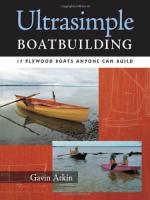|
This section contains 330 words (approx. 2 pages at 300 words per page) |
Sheets of plywood are made from thin layers of wood joined with glue. They are used to make a wide variety of products, including wall paneling; truck, airplane, and trailer bodies; furniture; cabinets; and counters.
Plywood is always made from an odd number of layers or plies (also called veneers) that are usually arranged so that the grain of one layer is at a right angle to the grain of the layer next to it. The outside layers are called "faces" and "backs," the ones directly next to those are "crossbands," and the inner layers make up the "core." These layers give equal strength to both the length and width, lessen expansion and contraction, and prevent splitting.
Today plywood is made from a log that is attached to a large lathe that spins against a cutter blade. This process produces a large, continuous sheet, which is then cut to size. The plies are glued together with various bonding agents, including synthetic plastics and resins. The wood is either softwood (mostly Douglas fir) or hardwood. (oak, poplar, birch, cherry, and walnut are among the more than 80 varieties used). The final sheets are usually 4 x 8 ft (1.22 x 2.44 m) and start at one quarter inch (6.35 mm) thick.
Though its use was not widespread before the introduction of mass production methods, plywood was employed in Ancient China and Egypt, and in Europe around 1830 by cabinetmaker Michael Thonet, who built chairs of veneer strips glued together. Plywood was introduced in the United States in 1865 and was first manufactured in Portland, Oregon, in 1905 by U.S. Plywood Corporation.
Plywood can be variously treated during its manufacture to instill it with several desired properties, a kind of wood-made-to-order. Exterior-type plywood is made with waterproof glue--it can also be used interiorly anywhere water is present. Plywood whose glue is only moisture-resistant can withstand an occasional soaking but not repeated soakings or continuous high humidity. Fire retardant and rot retardant plywood is also manufactured, used for roofing.
|
This section contains 330 words (approx. 2 pages at 300 words per page) |


